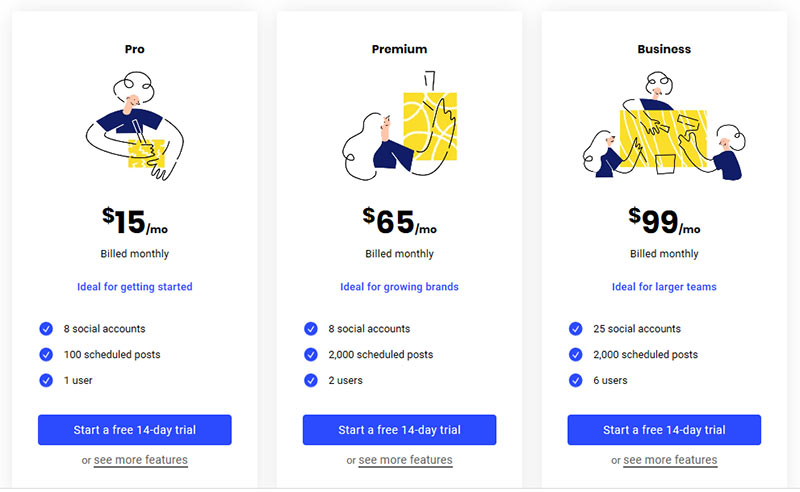Online shopping cart abandonment significantly eats into sales.
In essence, when a cart is considered ‘abandoned,’ it means a potential shopper had likely decided to purchase a product, but then never followed the buying process through to completion.
In 2015, CartHook was launched to mitigate the reasons why customers abandon carts—reasons which have been somewhat of a black hole of unknowns. The software as a service (SaaS) business’s customers can tap into its EmailMagnet product to automatically reach out to their customers who fail to complete their purchases. And the SaaS offering has clearly been a success.
According to Baremetrics—a SaaS analytics, forecasting, and engagement tools provider—CartHook used its success as an opportunity to increase its pricing significantly.
As Corey Haines pointed out, the subscription rate jumped from a $100 to $300, and the outcome was a pleasant surprise for CartHook’s founder and CEO, Jordan Gal.
Pricing started at $100/month because that’s where the incumbent was and we figured it was a good starting point,” wrote Gal. “We got overwhelmed with demand so we moved to $300/month to slow things down. Demand stayed exactly the same!”
SaaS Pricing Strategies: Debunking the ‘Low Price’ Myth
Is CartHook’s experience with raising prices an anomaly, or is a higher price less of a deterrent than some might believe?
Pricing products correctly is a significant concern for SaaS businesses, and with good reason. If a business prices its offerings too high, the price point might act as a prohibitive factor. On the other hand, if it prices too low, it can actually act as a deterrent.
One of the most common mistakes a business can make is to price its product too low. The perception is that if there are two like-products in the marketplace, a customer is going to lean toward the lower-priced product.
Setting aside SaaS products for a minute, let’s look at another popular product: beer.
In his book Priceless: The Myth of Fair Value, author William Poundstone illustrates a study where consumers were asked to purchase beer priced at different levels. When there were two differently priced beverages, 80% of consumers chose the higher-priced beer. When a third ‘bargain’ price was brought into the mix, not one person opted to try it.
So, if customers shy away from lower-cost products, why do businesses insist on undervaluing their services?
Let’s take a look at why a low price point can dilute your product offerings.
1. Low Prices Equate to a Lower Quality—at Least, Psychologically.
A price point that’s too low, especially when being compared to similar products, tends to give the impression that it’s inferior to the competitor.
For a customer, that lower-priced product may be perceived as a ‘risk’. Is that risk worth taking to save a couple of bucks? This psychological factor must be considered in any good pricing strategy.
If it’s saving a dollar on the store brand of cereal, it’s probably not that big of a deal.
However, in the SaaS world, budget software often equates to something that’s, at best, going to have a few bugs.
At worst, it may be a security risk.
And, in this era—in which we’re acutely aware of cybersecurity and the need to protect our personal information—a product that could compromise your digital safety isn’t worth the lower cost in the short term.
2. Underpricing Your Product Isn’t a Sustainable Strategy.
A product that’s priced too low isn’t going to sustain a company or allow it to grow quickly enough. In fact, it’s estimated that even a SaaS business that grows at a rate of 20% annually still has a 92% chance of failing. And a major component in that failure is cash flow—or lack thereof.
It’s tempting to price your product lower than you need to in order to acquire more customers, but if the profits aren’t going to be able to sustain your business, it’s all for naught.
This may be more obvious in a traditional manufacturing situation because there are material and manufacturing costs to consider.
But what about a SaaS business?
Consider this.
After examining the competition and factoring in your costs, you determine that the ideal subscription price for your software is $100 a month. You have 5,000 customers your business can support, from software engineers to customer service to billing specialists. Now let’s say that software is priced too low at $75 a month.
You have the same number of customers, the same amount of staff, but your profits are eroded by a product that’s underpriced.
Premium Pricing Doesn’t Need to Be Exclusive
Just as a price that’s too low can discourage customers, many businesses are concerned premium pricing may be just as much of a deterrent.
Also known as prestige pricing, the premium pricing strategy gives the impression that your product is higher quality than the competition’s product.
Recalling the example of the beer prices above, a whopping 80 percent of consumers chose the premium, highest-priced beverage.
The same concept holds true for other products, and often the higher-priced model may be more attractive than a lower-priced one, regardless of performance.
For some businesses, a premium price might simply be the paid alternative to a freemium version; often, the difference may be paying to have the ads removed.
For SaaS businesses, a premium subscription can actually be touted as the ‘middle’ level. That pricing point can differentiate between a more basic version of the product, while also being priced lower than a ‘business’ version.
Consider Buffer, a platform that manages social media. The company offers three primary tiers: one for an individual with fewer social media touches, a premium tier for growing businesses, and a business version for a greater number of users with more social media accounts.

Factors to Consider When Pricing Your Subscription Product
Clearly, assigning an outrageously high price is not a simple solution.
A business needs to do extensive market research on its ideal customer and where that customer’s needs lay. From there, it’s easier to carve out a viable price option: one that will help sustain your business, without undermining the integrity of your product.
There are several factors to consider.
1. The perceived value of your product.
There are two obvious ways to view the product a business is offering: The value of that product, and the perceived value of that product.
There’s a significant difference. The value of a product is generally determined by the cost that goes into creating it, with additional factors brought in for maintaining and supporting that product.
The perceived value is different. It brings other factors into the equation, including what are considered the three modes of communication.
- Credibility (also known as ethos)
- Emotional connection (pathos)
- Logical thinking (logos)
In the era of social media, credibility is a frontrunner.
Think about the last time you purchased a product online. Chances are, you looked at on-page customer reviews to validate the product’s worth. Software review sites such as Capterra and G2 Crowd can play a considerable part in the credibility of a product.
Then, there’s the emotional connection. Let’s say you’re getting ready to update your phone. Compared to some other brands, you’ve always wanted to make the switch to an Apple iPhone. It may cost more money than its competitors without, arguably, being any better, but ‘everyone’ has an iPhone.
What’s the difference?
A cell phone, whether it’s an Apple or a more budget-friendly phone, serves the same purpose: it makes calls. It sends texts. But an iPhone comes with the luxury factor, and that emotional piece is the most important selling point to you.
Finally, logic comes into play. For many customers, logic brings the perceived value full circle. Are they getting the best value for their money? Is it worth it? Apple fans would argue that the iPhone is well worth the spend for the ease of use and the integration with other Apple devices and the Apple ecosystem.
A business can address the logic component by digging into the data of your customer demographic and the need in the market.
2. Competitor action.
As the old saying goes, ‘Keep your friends close and your enemies closer.’ Knowing what your competition is doing can obviously help you map your own business and SaaS pricing strategy.
Are they offering new features? How are they pricing and promoting their business and its products?
Being familiar with your competitor’s offerings helps you know what’s going on in the marketplace… and use that knowledge to get a leg up. On the other hand, if you can see what your competition is doing, you better believe they’re watching you, too.
3. Market conditions.
This is no news flash: The marketplace is volatile. Not only are businesses looking to capture niche markets, but also consumer needs are in a constant state of flux. Supply and demand change, and not always as predicted.
Don’t believe it? Ask Kristoff, the ice salesman in the Disney movie Frozen. When your summer abruptly turns to winter, ice sales are likely to plummet.
Keep in mind that even when you settle on the optimal pricing plan for your product, your work is far from over. Careful reviewing and reporting will help you determine if your premium pricing strategy is too aggressive, or still needs to be tweaked.
In fact, CartHook’s price increases didn’t stop when it went from $100 to $300. In July 2019, the popular checkout app announced a base subscription increase to $500.
“Simply put,” they explained, “our merchants find more success when we work closely together as true partners. We’ve discovered something important: the closer the collaboration, the more fulfilling we find the work…This change in pricing and process allows us to build our software and our team in a way that provides merchants with the highest level of service possible.”
The SaaS pricing strategy is a challenging process because there are countless ways to price what you have to offer. It takes careful foresight, along with inventive approaches to determine what’s right for your products, your customers, and your business.
Establishing a premium pricing strategy means carefully meshing the perceived value of your product with an emotional connection to demonstrate why your product outshines your competitor.
Is this strategy right for your business?
FAQs about Premium Pricing Strategy
Q: What is a premium pricing strategy in a SaaS business?
A premium pricing strategy in a SaaS business is a tactic where the price of the product or service is set higher than the competitors in the market. It gives the impression that the offered product or service is of high quality compared to others in the competition.
Q: How does CartHook utilize a premium pricing strategy?
CartHook utilized a premium pricing strategy by increasing its subscription rate from $100 to $300 after it noticed a high demand for its product. Contrary to the expectation, the demand didn’t decrease, supporting the implementation of the premium pricing strategy.
Q: Why can low pricing be a deterrent for SaaS businesses?
Low pricing can act as a deterrent as it may give an impression to the customers that the product or service is of lower quality compared to others. This perception could make the product seem riskier to potential customers, thinking the lower cost might result in bugs or security risks.
Q: What is the effect of pricing a SaaS product too low?
A product that’s priced too low might not sustain a company or facilitate its growth. In the SaaS industry, underpricing can possibly lead to inadequate profits and, thus, a lack of financial sustenance for the business, ultimately increasing the chance of failure.
Q: How does a premium pricing strategy relate to the perceived value of a product?
A premium pricing strategy carefully aligns with the perceived value of a product. It gives the impression that the product is high quality compared to the competitors. When the higher price is justified through an emotional connection with the customers and credibility, it can lead to a higher perceived value and a successful pricing strategy.
Q: What factors should a business consider before setting a premium pricing strategy?
A business should examine the competition, the value of the product, the perceived value of the product considering credibility, emotional connection, logical thinking, demand and supply of the product in the market, and finally, the needs of the ideal customer demographic.
Q: How does premium pricing potentially affect customer behavior?
A premium pricing strategy can attract customers who perceive a higher-priced product as being of superior quality. This strategy can influence their buying decision and make them lean toward the higher-priced product, believing that performance, features, or status associated with the product justify the increased cost. However, the price must still align with the perceived value and benefits of the product for the customer.
Q: Can a premium pricing strategy lead to business growth and sustainability?
Yes, a successful premium pricing strategy can lead to business growth and sustainability. It permits companies to generate higher revenue per sale, enabling a faster recovery of costs and potentially facilitating investment in future growth. However, it requires a strong value proposition, a competitive product offering, and a deep understanding of the market and customer willingness to pay.








